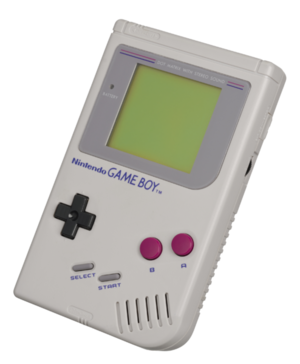Difference between revisions of "Configuration:Game Boy Pocket"
| Line 1: | Line 1: | ||
| − | {{Infobox System|Logo= | + | {{Infobox System|Logo=800px-Gameboy logo.png|Image=Game-Boy-FL.png|Year=1998|Manufacturer=Nintendo|Type=Handheld game console|CPU=Custom, Zilog Z80-|GPU=TBA|Sound CPU=TBA|Sound Chip=TBA|Memory=RAM: 32 kB<br />VRAM: 16 kB<br />Cartridge RAM: 128 kB|Controllers=Builtin}} |
== Platform Information == | == Platform Information == | ||
''from wikipedia'' | ''from wikipedia'' | ||
| − | The Game Boy | + | The Game Boy (Japanese: ゲームボーイ Hepburn: Gēmu Bōi?) is an 8-bit handheld video game device developed and manufactured by Nintendo. It was released in Japan on April 21, 1989, in North America on July 31, 1989, and in Europe on September 28, 1990. It is the first handheld console in the Game Boy line, and was created by Gunpei Yokoi and Nintendo Research & Development 1—the same staff who had designed the Game & Watch series as well as several popular games for the Nintendo Entertainment System.[7] Redesigned versions were released in 1996 and 1998, in the form of Game Boy Pocket, and Game Boy Light (Japan only), respectively. |
| − | The Game Boy | + | The Game Boy is Nintendo's second handheld system following the Game & Watch series introduced in 1980, and it combined features from both the Nintendo Entertainment System and Game & Watch.[7] It was originally bundled with the puzzle game Tetris.[8] |
| − | |||
| − | |||
| + | As part of the fourth generation of gaming, the Game Boy competed with the Sega Game Gear, Atari Lynx, and the TurboExpress. Despite these other handheld consoles,[9] the Game Boy was a tremendous success. The Game Boy and its successor, the Game Boy Color,[6] have both combined sold 118.69 million units worldwide. Upon its release in the United States, it sold its entire shipment of one million units within a few weeks.[10] | ||
=== Media Devices === | === Media Devices === | ||
* ROM Images | * ROM Images | ||
| Line 22: | Line 21: | ||
== External Links == | == External Links == | ||
| − | [https://en.wikipedia.org/wiki/ | + | [https://en.wikipedia.org/wiki/Game_Boy Wikipedia] |
[[Category:Platform]] | [[Category:Platform]] | ||
Revision as of 07:44, 22 May 2016
| Game Boy Pocket | ||
|---|---|---|

| ||

| ||
| Manufacturer | Nintendo | |
| Type | Handheld game console | |
| CPU | Custom, Zilog Z80- | |
| GPU | TBA | |
| Sound CPU | TBA | |
| Sound Chip | TBA | |
| Memory | RAM: 32 kB VRAM: 16 kB Cartridge RAM: 128 kB | |
| Controllers | Builtin | |
| Year | 1998 | |
Platform Information
from wikipedia
The Game Boy (Japanese: ゲームボーイ Hepburn: Gēmu Bōi?) is an 8-bit handheld video game device developed and manufactured by Nintendo. It was released in Japan on April 21, 1989, in North America on July 31, 1989, and in Europe on September 28, 1990. It is the first handheld console in the Game Boy line, and was created by Gunpei Yokoi and Nintendo Research & Development 1—the same staff who had designed the Game & Watch series as well as several popular games for the Nintendo Entertainment System.[7] Redesigned versions were released in 1996 and 1998, in the form of Game Boy Pocket, and Game Boy Light (Japan only), respectively.
The Game Boy is Nintendo's second handheld system following the Game & Watch series introduced in 1980, and it combined features from both the Nintendo Entertainment System and Game & Watch.[7] It was originally bundled with the puzzle game Tetris.[8]
As part of the fourth generation of gaming, the Game Boy competed with the Sega Game Gear, Atari Lynx, and the TurboExpress. Despite these other handheld consoles,[9] the Game Boy was a tremendous success. The Game Boy and its successor, the Game Boy Color,[6] have both combined sold 118.69 million units worldwide. Upon its release in the United States, it sold its entire shipment of one million units within a few weeks.[10]
Media Devices
- ROM Images
BIOS
A BIOS image from a Game Boy Color is required to play Classic Game Boy games in Color. A BIOS image should be dumped from your own hardware. Using the Game Boy Color BIOS, MESS will colorize Game Boy Classic games as if they were in a real Game Boy Color. Mednafen will run them as regular Game Boy Games and they will be gray scale.
Available Emulators
Below is a list of available emulators for this platform.